Climate Change as a Double-Edged Sword: Exploring the Potential of Environmental Recovery to Foster Stability in Darfur, Sudan
Abstract
:1. Introduction
2. Materials and Methods
2.1. Study Area
2.2. Data Source and Preprocessing
2.2.1. Vegetation Index
2.2.2. Vegetation Trend Analysis
2.2.3. Rainfall and Temperature Dataset
2.2.4. Drought Analysis
2.2.5. Innovative Trend Analysis (ITA)
2.2.6. Rainfall Time Series Forecasting
2.2.7. Breaks for Additive Seasonal and Trend (BFAST) Method
3. Results
3.1. Rainfall
3.1.1. Rainfall Distribution
3.1.2. Rainfall Trends
3.1.3. Spatio-Temporal Variability in Rainfall Pattern
3.1.4. Rainfall Forecast
3.2. Temperature Trends
3.3. Drought Analysis Results
3.3.1. Drought Intensity
3.3.2. Temporal Variation of Drought
3.4. Vegetation Cover
3.4.1. EVI Classification Statistics and Maps
3.4.2. Spatial Distribution of Vegetation Cover Change
4. Discussion
4.1. Climate Change in Darfur
4.2. The Potential of Climate-Change-Induced Environmental Recovery in Mitigating Resource-Based Conflict in Darfur
5. Conclusions
Author Contributions
Funding
Data Availability Statement
Acknowledgments
Conflicts of Interest
References
- Marou, V.; Vardavas, C.I.; Aslanoglou, K.; Nikitara, K.; Plyta, Z.; Leonardi-Bee, J.; Atkins, K.; Condell, O.; Lamb, F.; Suk, J.E. The Impact of Conflict on Infectious Disease: A Systematic Literature Review. Confl. Health 2024, 18, 27. [Google Scholar] [CrossRef]
- Almulhim, A.I.; Alverio, G.N.; Sharifi, A.; Shaw, R.; Huq, S.; Mahmud, J.; Ahmad, S.; Rimi Abubakar, I. Climate-Induced Migration in the Global South: An in Depth Analysis. Npj Clim. Action 2024, 3, 47. [Google Scholar] [CrossRef]
- Xu, L.; Famiglietti, J.S.; Li Xu, C.; Mirumachi, N.; Editor, A.; Jepson, W.; Seibert, J. Global Patterns of Water-driven Human Migration. Wiley Interdiscip. Rev. Water 2023, 10, e1647. [Google Scholar] [CrossRef]
- Palinkas, L.A. Fleeing Drought: The Great Migration to Europe. In Global Climate Change, Population Displacement, and Public Health; Springer: Berlin, Germany, 2020; pp. 71–98. [Google Scholar] [CrossRef]
- Arora, P.; Arora, N.K. COP27: A Summit of More Misses than Hits. Environ. Sustain. 2023, 6, 99–105. [Google Scholar] [CrossRef]
- Busby, J.W.; Cook, K.H.; Vizy, E.K.; Smith, T.G.; Bekalo, M. Identifying Hot Spots of Security Vulnerability Associated with Climate Change in Africa. Clim. Change 2014, 124, 717–731. [Google Scholar] [CrossRef]
- Basheer, M.; Elagib, N.A. Armed Conflict as a Catalyst for Increasing Flood Risk. Environ. Res. Lett. 2024, 19, 104034. [Google Scholar] [CrossRef]
- Trummer, U.; Ali, T.; Mosca, D.; Mukuruva, B.; Mwenyango, H.; Novak-Zezula, S. Climate Change Aggravating Migration and Health Issues in the African Context: The Views and Direct Experiences of a Community of Interest in the Field. J. Migr. Health 2023, 7, 100151. [Google Scholar] [CrossRef] [PubMed]
- Alriah, M.A.A.; Bi, S.; Nkunzimana, A.; Elameen, A.M.; Sarfo, I.; Ayugi, B. Assessment of Observed Changes in Drought Characteristics and Recent Vegetation Dynamics over Arid and Semiarid Areas in Sudan. Theor. Appl. Climatol. 2024, 155, 3541–3561. [Google Scholar] [CrossRef]
- Ferrari, G.; Ai, P.; Alengebawy, A.; Marinello, F.; Pezzuolo, A. An Assessment of Nitrogen Loading and Biogas Production from Italian Livestock: A Multilevel and Spatial Analysis. J. Clean. Prod. 2021, 317, 128388. [Google Scholar] [CrossRef]
- Abugabr Elhag, H.E.E.; Baleela, R.M.H. Preliminary Investigation and Analysis of the Impact of the Sudan War on Higher Education and Scientific Research Sectors. Int. J. Educ. Dev. 2024, 112, 103190. [Google Scholar] [CrossRef]
- Robyn, S. The Water Scarcity-Conflict Nexus: The Case of Darfur. Ph.D. Thesis, Stellenbosch University, Stellenbosch, South Africa, 2017; pp. 1–146. [Google Scholar]
- Bromwich, B. Power, Contested Institutions and Land: Repoliticising Analysis of Natural Resources and Conflict in Darfur. J. East. Afr. Stud. 2018, 12, 1–21. [Google Scholar] [CrossRef]
- Mirumachi, N.; Sawas, A.; Workman, M. Unveiling the Security Concerns of Low Carbon Development: Climate Security Analysis of the Undesirable and Unintended Effects of Mitigation and Adaptation. Clim. Dev. 2020, 12, 97–109. [Google Scholar] [CrossRef]
- Linke, J. Women in Peace and Transition Processes. Sudan, Darfur (2009–2017). Inclusive Peace & Transition Initiatives 2018. pp. 1–16. Available online: https://repository.graduateinstitute.ch/record/296601?v=pdf (accessed on 7 January 2025).
- ACAP. Thematic Report: Sudan’s Impact of the Current Conflict on WASH Needs. In ACAPS Analysis Hub. 2023. Available online: https://www.Acaps.Org/Fileadmin/Data_Product/Main_media/20230911_ACAPS_thematic_report_Sudan_impact_of_current_conflict_on_WASH_needs.pdf (accessed on 19 December 2024).
- OCHA Sudan Humanitarian Update (29 July 2024) [EN/AR]|OCHA. Available online: https://www.unocha.org/publications/report/sudan/sudan-humanitarian-update-29-july-2024 (accessed on 17 November 2024).
- Hagenlocher, M.; Lang, S.; Tiede, D. Integrated Assessment of the Environmental Impact of an IDP Camp in Sudan Based on Very High Resolution Multi-Temporal Satellite Imagery. Remote Sens. Environ. 2012, 126, 27–38. [Google Scholar] [CrossRef]
- Hardt, J.N.; Scheffran, J. Environmental Peacebuilding and Climate Change: Peace and Conflict Studies at the Edge of Transformation. Policy Brief 2019, 68, 1–20. [Google Scholar]
- Akasha, M. Darfur: A Tragedy of Climate Change; Anchor Academic Publishing: Hamburg, Germany, 2013. [Google Scholar]
- Ahmed, A.; Rotich, B.; Czimber, K. Assessment of the Environmental Impacts of Conflict-Driven Internally Displaced Persons: A Sentinel-2 Satellite Based Analysis of Land Use/Cover Changes in the Kas Locality, Darfur, Sudan. PLoS ONE 2024, 19, e0304034. [Google Scholar] [CrossRef]
- Younis, A.Y.I.; Jonathan, B.N.; Togun, A.O.; Yasin, E.H.E.; Omer, S.O.; Hamad, G.E.A.I.; Aïssata, S.D. Assessment of Land Use and Land Cover Change on Gum Talha (Acacia Seyal Var. Seyal) Forest in Bahar Alarab, Sudan. Biodiversitas 2022, 23, 4549–4560. [Google Scholar] [CrossRef]
- Kranz, O.; Sachs, A.; Lang, S. Assessment of Environmental Changes Induced by Internally Displaced Person (IDP) Camps in the Darfur Region, Sudan, Based on Multitemporal MODIS Data. Int. J. Remote Sens. 2015, 36, 190–210. [Google Scholar] [CrossRef]
- OCHA Sudan OCHA: The Sudan Humanitarian Fund. Available online: https://www.unocha.org/sudan (accessed on 17 November 2024).
- Solomon, N.; Birhane, E.; Gordon, C.; Haile, M.; Taheri, F.; Azadi, H.; Scheffran, J. Environmental Impacts and Causes of Conflict in the Horn of Africa: A Review. Earth Sci. Rev. 2018, 177, 284–290. [Google Scholar] [CrossRef]
- Xie, X.; Hao, M.; Ding, F.; Scheffran, J.; Ide, T.; Maystadt, J.F.; Qian, Y.; Wang, Q.; Chen, S.; Wu, J.; et al. The Impacts of Climate Change on Violent Conflict Risk: A Review of Causal Pathways. Environ. Res. Commun. 2024, 6, 112002. [Google Scholar] [CrossRef]
- AbdelRahman, M.A.E. An Overview of Land Degradation, Desertification and Sustainable Land Management Using GIS and Remote Sensing Applications. Rend. Lincei. Sci. Fis. Nat. 2023, 34, 767–808. [Google Scholar] [CrossRef]
- D’Acunto, F.; Marinello, F.; Pezzuolo, A. Rural Land Degradation Assessment through Remote Sensing: Current Technologies, Models, and Applications. Remote Sens. 2024, 16, 3059. [Google Scholar] [CrossRef]
- Dubovyk, O. The Role of Remote Sensing in Land Degradation Assessments: Opportunities and Challenges. Eur. J. Remote Sens. 2017, 50, 601–613. [Google Scholar] [CrossRef]
- Ahmed, T.; Singh, D. Probability Density Functions Based Classification of MODIS NDVI Time Series Data and Monitoring of Vegetation Growth Cycle. Adv. Space Res. 2020, 66, 873–886. [Google Scholar] [CrossRef]
- Majdaldin, A.R.; Osunmadewa, B.A.; Csaplovics, E.; Aralova, D. Remote Sensing-Based Vegetation Indices for Monitoring Vegetation Change in the Semi-Arid Region of Sudan. In Remote Sensing for Agriculture, Ecosystems, and Hydrology XVIII; SPIE: Bellingham, WA, USA, 2016; Volume 9998, pp. 609–617. [Google Scholar] [CrossRef]
- Camps-Valls, G.; Campos-Taberner, M.; Moreno-Martínez, Á.; Walther, S.; Duveiller, G.; Cescatti, A.; Mahecha, M.D.; Muñoz-Marí, J.; García-Haro, F.J.; Guanter, L.; et al. A Unified Vegetation Index for Quantifying the Terrestrial Biosphere. Sci. Adv. 2021, 7, eabc7447. [Google Scholar] [CrossRef] [PubMed]
- Villarroya-Carpio, A.; Lopez-Sanchez, J.M.; Engdahl, M.E. Sentinel-1 Interferometric Coherence as a Vegetation Index for Agriculture. Remote Sens. Environ. 2022, 280, 113208. [Google Scholar] [CrossRef]
- Schyns, J.F.; Hoekstra, A.Y.; Booij, M.J. Review and Classification of Indicators of Green Water Availability and Scarcity. Hydrol. Earth Syst. Sci. 2015, 19, 4581–4608. [Google Scholar] [CrossRef]
- Lee, S.; Moriasi, D.N.; Danandeh Mehr, A.; Mirchi, A. Sensitivity of Standardized Precipitation and Evapotranspiration Index (SPEI) to the Choice of SPEI Probability Distribution and Evapotranspiration Method. J. Hydrol. Reg. Stud. 2024, 53, 101761. [Google Scholar] [CrossRef]
- Meresa, H.; Zhang, Y.; Tian, J.; Abrar Faiz, M. Understanding the Role of Catchment and Climate Characteristics in the Propagation of Meteorological to Hydrological Drought. J. Hydrol. 2023, 617, 128967. [Google Scholar] [CrossRef]
- McKee, T.B.; Doesken, N.J.; Kleist, J. The Relationship of Drought Frequency and Duration to Time Scales. In Proceedings of the 8th Conference on Applied Climatology, Anaheim, CA, USA, 17–22 January 1993; pp. 17–22. [Google Scholar]
- Ahmadalipour, A.; Moradkhani, H.; Demirel, M.C. A Comparative Assessment of Projected Meteorological and Hydrological Droughts: Elucidating the Role of Temperature. J. Hydrol. 2017, 553, 785–797. [Google Scholar] [CrossRef]
- Diffenbaugh, N.S.; Swain, D.L.; Touma, D. Anthropogenic Warming Has Increased Drought Risk in California. Proc. Natl. Acad. Sci. USA 2015, 112, 3931–3936. [Google Scholar] [CrossRef]
- Vicente-Serrano, S.M.; Beguería, S.; López-Moreno, J.I. A Multiscalar Drought Index Sensitive to Global Warming: The Standardized Precipitation Evapotranspiration Index. J. Clim. 2010, 23, 1696–1718. [Google Scholar] [CrossRef]
- Library, W.O.; Stagge, J.H.; Tallaksen, L.M.; Gudmundsson, L.; Van Loon, A.F.; Stahl, K. Candidate Distributions for Climatological Drought Indices (SPI and SPEI). Int. J. Climatol. 2015, 35, 4027–4040. [Google Scholar] [CrossRef]
- Gurrapu, S.; Chipanshi, A.; Sauchyn, D.; Howard, A. Comparison of the SPI and SPEI on Predicting Drought Conditions and Streamflow in the Canadian Prairies. In Proceedings of the 28th Conference on Hydrology, Atlanta, GA, USA, 2–6 February 2014. [Google Scholar]
- Vicente-Serrano, S.M.; Beguería, S.; Lorenzo-Lacruz, J.; Julio Camarero, J.; López-Moreno, J.I.; Azorin-Molina, C.; Revuelto, J.; Morán-Tejeda, E.; Sanchez-Lorenzo, A.; Pirenaico de Ecología, I. Performance of Drought Indices for Ecological, Agricultural, and Hydrological Applications. Earth Interact. 2012, 16, 1–27. [Google Scholar] [CrossRef]
- Verbesselt, J.; Hyndman, R.; Zeileis, A.; Culvenor, D. Phenological Change Detection While Accounting for Abrupt and Gradual Trends in Satellite Image Time Series. Remote Sens. Environ. 2010, 114, 2970–2980. [Google Scholar] [CrossRef]
- Fang, X.; Zhu, Q.; Ren, L.; Chen, H.; Wang, K.; Peng, C. Large-Scale Detection of Vegetation Dynamics and Their Potential Drivers Using MODIS Images and BFAST: A Case Study in Quebec, Canada. Remote Sens. Environ. 2018, 206, 391–402. [Google Scholar] [CrossRef]
- Wang, Y.; Liu, G.; Guo, E. Spatial Distribution and Temporal Variation of Drought in Inner Mongolia during 1901–2014 Using Standardized Precipitation Evapotranspiration Index. Sci. Total Environ. 2019, 654, 850–862. [Google Scholar] [CrossRef]
- He, B.; Chang, J.; Wang, Y.; Wang, Y.; Zhou, S.; Chen, C. Spatio-Temporal Evolution and Non-Stationary Characteristics of Meteorological Drought in Inland Arid Areas. Ecol. Indic. 2021, 126, 107644. [Google Scholar] [CrossRef]
- Young, B.H.; Fitzpatrick, M.; Marshak, A.; Radday, A. Lessons for Taadoud II: Improving Natural Resource Management; Feinstein International Center: Boston, MA, USA, 2019. [Google Scholar]
- Nweke, A.C. Transition From Fragility to Sustainable Development: Case Study of Darfur in Sudan. Ph.D. Thesis, Walden University, Minneapolis, MN, USA, 2021. [Google Scholar]
- Vehnämäki, M. Darfur Scorched: Looming Genocide in Western Sudan1. J. Genocide Res. 2006, 8, 51–82. [Google Scholar] [CrossRef]
- Osman, M.A.A.; Abdel-Rahman, E.M.; Onono, J.O.; Olaka, L.A.; Elhag, M.M.; Adan, M.; Tonnang, H.E.Z. Mapping, Intensities and Future Prediction of Land Use/Land Cover Dynamics Using Google Earth Engine and CA- Artificial Neural Network Model. PLoS ONE 2023, 18, e0288694. [Google Scholar] [CrossRef]
- Jakata, C. Mapping and Monitoring the Impacts of Climate Variabilities on Rangelands in North Darfur, Sudan. Master’s Thesis, University of the Witwatersrand, Johannesburg, South Africa, 2021. [Google Scholar]
- Hegazy, A.K.; Hosni, H.A.; El-Sheikh, M.A.R.; Abo-El-Kassem, A.; Badawi, E.S.M.; Lovett-Doust, L. Plant Biodiversity and Soils in the Jebel Marra Region of Darfur, Sudan. Arid Land Res. Manag. 2021, 35, 127–161. [Google Scholar] [CrossRef]
- Wickens, G.E.; Collier, F.W. Some Vegetation Patterns in the Republic of the Sudan. Geoderma 1971, 6, 43–59. [Google Scholar] [CrossRef]
- Al-Amin, H.A. Trees and Shrubs of the Sudan. Ithaca Press, 484p.—References—Scientific Research Publishing. 1990. Available online: https://www.scirp.org/reference/referencespapers?referenceid=1805810 (accessed on 24 February 2025).
- Ahmed, A.I.A.; Eldoma, I.M.; Elaagip, E.E.M.A.H.; Hou, F. Effects of Indigenous Cultivation Practices on Soil Conservation in the Hilly Semiarid Areas of Western Sudan. Water 2020, 12, 1554. [Google Scholar] [CrossRef]
- Hegazy, A.K.; Hosni, H.A.; Kabiel, H.F.; Badawi, E.S.M.; Emam, M.H.; Lovett-Doust, L. Population Ecology of Some Keystone Tree Species in the Jebel Marra Region of Darfur. Rend. Lincei. Sci. Fis. Nat. 2018, 29, 659–673. [Google Scholar] [CrossRef]
- Nagmeldin, K.-G.; Hanna, R.-A. Ethnic Diversity and Its Impact on Group Identification in Darfur. Stud. Afr. Lang. Cult. 2023, 57, 2023. [Google Scholar] [CrossRef]
- Atta Al-Mannan, A.Y. Attaalmannan Traditional Tribal Conflicts in Darfur Reasons and Seasons. J. Educ. Pract. 2019, 10, 95–110. [Google Scholar] [CrossRef]
- Schimmer, R. Tracking the Genocide in Darfur: Population Displacement as Recorded by Remote Sensing; Yale Center for International and Area Studies: New Haven, CT, USA, 2007. [Google Scholar]
- Nugent, B.; Zambakides, S.; Abaker, M.; Adam, A.; Gutbi, O.; Eltigani, E. Profile of Nyala Town and Adjacent IDP Camps Darfur. Available online: https://unhabitat.org/sites/default/files/download-manager-files/Nyala%20and%20Adjacent%20IDP%20Camps%20Profile.pdf (accessed on 22 December 2024).
- Elamin, E.M. Assessment of Sustainable Production of Stable Food Crops in Southern Darfur State, Sudan. Curr. Investig. Agric. Curr. Res. 2018, 5, 609–611. [Google Scholar] [CrossRef]
- Didan, K.; Munoz, A.B.; Solano, R.; Huete, A. MODIS Vegetation Index User’s Guide (MOD13 Series); University of Arizona, Vegetation Index and Phenology Lab: Tucson, AZ, USA, 2015; pp. 1–33. [Google Scholar]
- LP DAAC Global 250 m SIN Grid V006. NASA Land Data Products and Services. 2015. Available online: https://lpdaac.usgs.gov/products/mod13q1v006/ (accessed on 23 January 2025).
- Sur, K.; Verma, V.K.; Panwar, P.; Shukla, G.; Chakravarty, S.; Nath, A.J. Monitoring Vegetation Degradation Using Remote Sensing and Machine Learning over India—A Multi-Sensor, Multi-Temporal and Multi-Scale Approach. Front. For. Glob. Change 2024, 7, 1382557. [Google Scholar] [CrossRef]
- Zhang, H.; Chang, J.; Zhang, L.; Wang, Y.; Li, Y.; Wang, X. NDVI Dynamic Changes and Their Relationship with Meteorological Factors and Soil Moisture. Environ. Earth Sci. 2018, 77, 582. [Google Scholar] [CrossRef]
- Liu, Z.; Chen, Y.; Chen, C. Analysis of the Spatiotemporal Characteristics and Influencing Factors of the NDVI Based on the GEE Cloud Platform and Landsat Images. Remote Sens. 2023, 15, 4980. [Google Scholar] [CrossRef]
- Olaf, K.; Gunter, Z.; Dirk, T.; Stephen, C.; Denis, B.; Thomas, K.; Stefan, L.; Mathidlde, C. Monitoring Refugee IDP Camps to Support International Relief Action. 2016. Available online: https://elib.dlr.de/68874/1/KRANZetal_2010_UNBOOKLET.pdf (accessed on 8 March 2024).
- Lang, S.; Tiede, D.; Hölbling, D.; Füreder, P.; Zeil, P. Earth Observation (EO)-Based Ex Post Assessment of Internally Displaced Person (IDP) Camp Evolution and Population Dynamics in Zam Zam, Darfur. Int. J. Remote Sens. 2010, 31, 5709–5731. [Google Scholar] [CrossRef]
- Funk, C.; Michaelsen, J.; Marshall, M.T. Mapping Recent Decadal Climate Variations in Precipitation and Temperature Across Eastern Africa and the Sahel. 2012. Available online: https://digitalcommons.unl.edu/usgsstaffpub/977/ (accessed on 22 September 2024).
- Gupta, P.; Verma, S.; Bhatla, R.; Chandel, A.S.; Singh, J.; Payra, S. Validation of Surface Temperature Derived From MERRA-2 Reanalysis Against IMD Gridded Data Set Over India. Earth Space Sci. 2020, 7, e2019EA000910. [Google Scholar] [CrossRef]
- Westberg, D.J.; Stackhouse, P.; Crawley, D.B.; Hoell, J.M.; Chandler, W.S.; Zhang, T. An Analysis of NASA&39;s MERRA Meteorological Data to Supplement Observational Data for Calculation of Climatic Design Conditions|SG Publications. Available online: https://esdpubs.nasa.gov/sgpubs/content/An_Analysis_of_NASAs_MERRA_Meteorological_Data_to_Supplement_Observational_Data_for (accessed on 22 December 2024).
- Kleist, D.T.; Parrish, D.F.; Derber, J.C.; Treadon, R.; Errico, R.M.; Yang, R. Improving Incremental Balance in the GSI 3DVAR Analysis System. Mon. Weather Rev. 2009, 137, 1046–1060. [Google Scholar] [CrossRef]
- Molod, A.; Takacs, L.; Suarez, M.; Bacmeister, J. Development of the GEOS-5 Atmospheric General Circulation Model: Evolution from MERRA to MERRA2. Geosci. Model Dev. 2015, 8, 1339–1356. [Google Scholar] [CrossRef]
- Vicente-Serrano, S.M.; Lopez-Moreno, J.I.; Beguería, S.; Lorenzo-Lacruz, J.; Sanchez-Lorenzo, A.; García-Ruiz, J.M.; Azorin-Molina, C.; Morán-Tejeda, E.; Revuelto, J.; Trigo, R.; et al. Evidence of Increasing Drought Severity Caused by Temperature Rise in Southern Europe. Environ. Res. Lett. 2014, 9, 044001. [Google Scholar] [CrossRef]
- Bae, S.; Lee, S.H.; Yoo, S.H.; Kim, T. Analysis of Drought Intensity and Trends Using the Modified SPEI in South Korea from 1981 to 2010. Water 2018, 10, 327. [Google Scholar] [CrossRef]
- Tirivarombo, S.O.D.E.; Osupile, D.; Eliasson, P. Drought Monitoring and Analysis: Standardised Precipitation Evapotranspiration Index (SPEI) and Standardised Precipitation Index (SPI); Elsevier: Amsterdam, The Netherlands, 2018. [Google Scholar]
- Serkendiz, H.; Tatli, H.; Kılıç, A.; Çetin, M.; Sungur, A. Analysis of Drought Intensity, Frequency and Trends Using the SPEI in Turkey. Theor. Appl. Climatol. 2024, 155, 2997–3012. [Google Scholar] [CrossRef]
- Şen, Z. Innovative Trend Analysis Methodology. J. Hydrol. Eng. 2012, 17, 1042–1046. [Google Scholar] [CrossRef]
- Kessabi, R.; Hanchane, M.; Ait Brahim, Y.; El Khazzan, B.; Addou, R.; Belmahi, M. Characterization of Annual and Seasonal Rainfall Trend Using Innovative Trend Analysis (ITA) and Classical Methods: The Case of Wadi Sebou Basin (WSB) Morocco. Euro-Mediterr. J. Environ. Integr. 2024, 1–19. [Google Scholar] [CrossRef]
- Zittis, G. Observed Rainfall Trends and Precipitation Uncertainty in the Vicinity of the Mediterranean, Middle East and North Africa. Theor. Appl. Climatol. 2018, 134, 1207–1230. [Google Scholar] [CrossRef]
- Murat, M.; Malinowska, I.; Gos, M.; Krzyszczak, J. Forecasting Daily Meteorological Time Series Using ARIMA and Regression Models. Int. Agrophys. 2018, 32, 253–264. [Google Scholar] [CrossRef]
- Box, G.E.P.; Jenkins, G.M.; Reinsel, G.C.; Ljung, G.M. Time Series Analysis: Forecasting and Control. In Time Series Analysis: Forecasting and Control; John Wiley & Sons: Hoboken, NJ, USA, 2016. [Google Scholar]
- Harvey, A.C. Forecasting, Structural Time Series Models and the Kalman Filter; Cambridge University Press: Cambridge, UK, 1994; p. 554. [Google Scholar]
- Hyndman, R.; Koehler, A.B.; Ord, J.K.; Snyder, R.D. Forecasting with Exponential Smoothing: The State Space Approach—Rob Hyndman. Available online: https://books.google.ro/books?hl=en&lr=&id=GSyzox8Lu9YC&oi=fnd&pg=PA3&dq=Snyder+Forecasting+with+Exponential+Smoothing:+The+State+Space+Approach%E2%80%94Rob+Hyndman&ots=1s6pEJlFt3&sig=ookFHv7Jwlw8kP-H0Viics6nZxI&redir_esc=y#v=onepage&q=Snyder%20Forecasting%20with%20Exponential%20Smoothing%3A%20The%20State%20Space%20Approach%E2%80%94Rob%20Hyndman&f=false (accessed on 17 October 2024).
- Agaj, T.; Budka, A.; Janicka, E.; Bytyqi, V. Using ARIMA and ETS Models for Forecasting Water Level Changes for Sustainable Environmental Management. Sci. Rep. 2024, 14, 22444. [Google Scholar] [CrossRef]
- Siddig, K.; Stepanyan, D.; Wiebelt, M.; Grethe, H.; Zhu, T. Climate Change and Agriculture in the Sudan: Impact Pathways beyond Changes in Mean Rainfall and Temperature. Ecol. Econ. 2020, 169, 106566. [Google Scholar] [CrossRef]
- Nwayor, I.J.; Robeson, S.M. Exploring the Relationship between SPI and SPEI in a Warming World. Theor. Appl. Climatol. 2024, 155, 2559–2569. [Google Scholar] [CrossRef]
- Onyango, D.O. Climate Change and Conflict: A Case Study of Darfur Conflict. Ph.D. Thesis, University of Nairobi, Nairobi, Kenya, 2013. [Google Scholar]
- Sax, N.; Hassan, G.; Abdi, A.; Madurga-Lopez, I. How Does Climate Exacerbate Root Causes of Conflict in Sudan. 2023. Available online: https://cgspace.cgiar.org/server/api/core/bitstreams/12f43867-fb02-4f3a-ae4e-1599ef6d713b/content (accessed on 14 January 2025).
- Scholarworks, U.; Smith, E.G. Climate Change and Conflict: The Darfur Conflict and Syrian Civil War; The University of Vermont: Burlington, VT, USA, 2020. [Google Scholar]
- Scholarworks, U.; Smith, E.G. Climate Change and Darfur: A Holistic Security Approach. Master’s Thesis, American University in Cairo, New Cairo, Egypt, 2023. [Google Scholar]
- Naz, U.; Saleem, M.S. Climate-Induced Vulnerabilities: Conflict and Migration Patterns in the Sahel Region of Africa. Pak. Lang. Humanit. Rev. 2024, 8, 295–311. [Google Scholar]
- Macauley, T. Darfur, Conflict and Climate Change. Master’s Thesis, Duke University, Durham, NC, USA, 2008. [Google Scholar]
- Macauley, T. Climate and Crisis: Environmental Degradation and Humanitarian Disaster in Darfur. Master’s Thesis, Fordham University, Bronx, NY, USA, 2016. [Google Scholar]
- Elnour Yagoub, Y.; Li, Z.; Said Musa, O.; Wang, F.; Naveed Anjum, M.; Bo, Z.; Ding-min, J. Detection of Drought Pattern in Sudan Using Standardized Precipitation-Evapotranspiration Index (SPEI). Int. J. Recent Adv. Multidiscip. Res. 2017, 4, 2546–2554. [Google Scholar]
- Marvel, K.; Su, W.; Delgado, R.; Aarons, S.; Chatterjee, A.; Garcia, M.E.; Hausfather, Z.; Hayhoe, K.; Hence, D.A.; Jewett, E.B.; et al. Chapter 2: Climate Trends. In Fifth National Climate Assessment; U.S. Global Change Research Program: Washington, DC, USA, 2023; pp. 2–17. [Google Scholar] [CrossRef]
- Hemida, M. The Potentiality of Agroforestry Practices as Essential Land Use Option for Forest Rehabilitation and Livelihood Improvement, Case Study of Nabag Forest. Ph.D. Thesis, University of Sopron, Sopron, Hungary, 2023. [Google Scholar]
- Mbuqwa, P.; Magagula, H.B.; Kalumba, A.M.; Afuye, G.A. Interdecadal Variations in Agricultural Drought Monitoring Using Land Surface Temperature and Vegetation Indices: A Case of the Amahlathi Local Municipality in South Africa. Sustainability 2024, 16, 8125. [Google Scholar] [CrossRef]
- Keria, H.; Bensaci, E.; Zoubiri, A. Assessment of the Long-Term Effects of Climate on Vegetation in 25 Watersheds in Dry and Semi-Dry Areas, Algeria. Nat. Hazards 2024, 120, 7575–7596. [Google Scholar] [CrossRef]
- Mwabumba, M.; Yadav, B.K.; Rwiza, M.J.; Larbi, I.; Dotse, S.Q.; Limantol, A.M.; Sarpong, S.; Kwawuvi, D. Rainfall and Temperature Changes under Different Climate Scenarios at the Watersheds Surrounding the Ngorongoro Conservation Area in Tanzania. Environ. Chall. 2022, 7, 100446. [Google Scholar] [CrossRef]
- Van Lanen, H.A.J.; Wanders, N.; Tallaksen, L.M.; Van Loon, A.F. Hydrological Drought across the World: Impact of Climate and Physical Catchment Structure. Hydrol. Earth Syst. Sci. 2013, 17, 1715–1732. [Google Scholar] [CrossRef]
- Shai, K.B.; Vunza, M. Gender Mainstreaming in Peacebuilding and Localised Human Security in the Context of the Darfur Genocide: An Africentric Rhetorical Analysis. J. Lit. Stud. 2021, 37, 69–84. [Google Scholar] [CrossRef]
- Papa, M.J.; Papa, W.H. The Crisis in Darfur and the Social Structure of Global Climate Change, race, and gender. Stud. Symb. Interact. 2019, 51, 43–70. [Google Scholar] [CrossRef]
- Adaawen, S.; Rademacher-Schulz, C.; Schraven, B.; Segadlo, N. Drought, Migration, and Conflict in Sub-Saharan Africa: What Are the Links and Policy Options? Curr. Dir. Water Scarcity Res. 2019, 2, 15–31. [Google Scholar] [CrossRef]
- Adams, E.A.; Thill, A.; Kuusaana, E.D.; Mittag, A. Farmer–Herder Conflicts in Sub-Saharan Africa: Drivers, Impacts, and Resolution and Peacebuilding Strategies. Environ. Res. Lett. 2023, 18, 123001. [Google Scholar] [CrossRef]
- Hakim, S. The Role of Climate Change in the Darfur Crisis. Clim. Change Manag. 2011, 815–823. [Google Scholar] [CrossRef]
- Mazo, J. Chapter Four: Conflict, Instability and State Failure: The Climate Factor. Adelphi Pap. 2009, 49, 87–118. [Google Scholar] [CrossRef]
- Levy, B.S. Increasing Risks for Armed Conflict: Climate Change, Food and Water Insecurity, and Forced Displacement. Int. J. Health Serv. 2019, 49, 682–691. [Google Scholar] [CrossRef] [PubMed]
- Olsson, O. Resource Conflict in Vulnerable Environments: Three Models Applied to Darfur. Work. Pap. Econ. 2008, 325, 16–41. [Google Scholar]
- Ebi, K.L.; Hallegatte, S.; Kram, T.; Arnell, N.W.; Carter, T.R.; Edmonds, J.; Kriegler, E.; Mathur, R.; O’Neill, B.C.; Riahi, K.; et al. A New Scenario Framework for Climate Change Research: Background, Process, and Future Directions. Clim. Change 2014, 122, 363–372. [Google Scholar] [CrossRef]
- van Vuuren, D.P.; Edmonds, J.; Kainuma, M.; Riahi, K.; Thomson, A.; Hibbard, K.; Hurtt, G.C.; Kram, T.; Krey, V.; Lamarque, J.-F.; et al. The Representative Concentration Pathways: An Overview. Clim. Change 2011, 109, 5–31. [Google Scholar] [CrossRef]

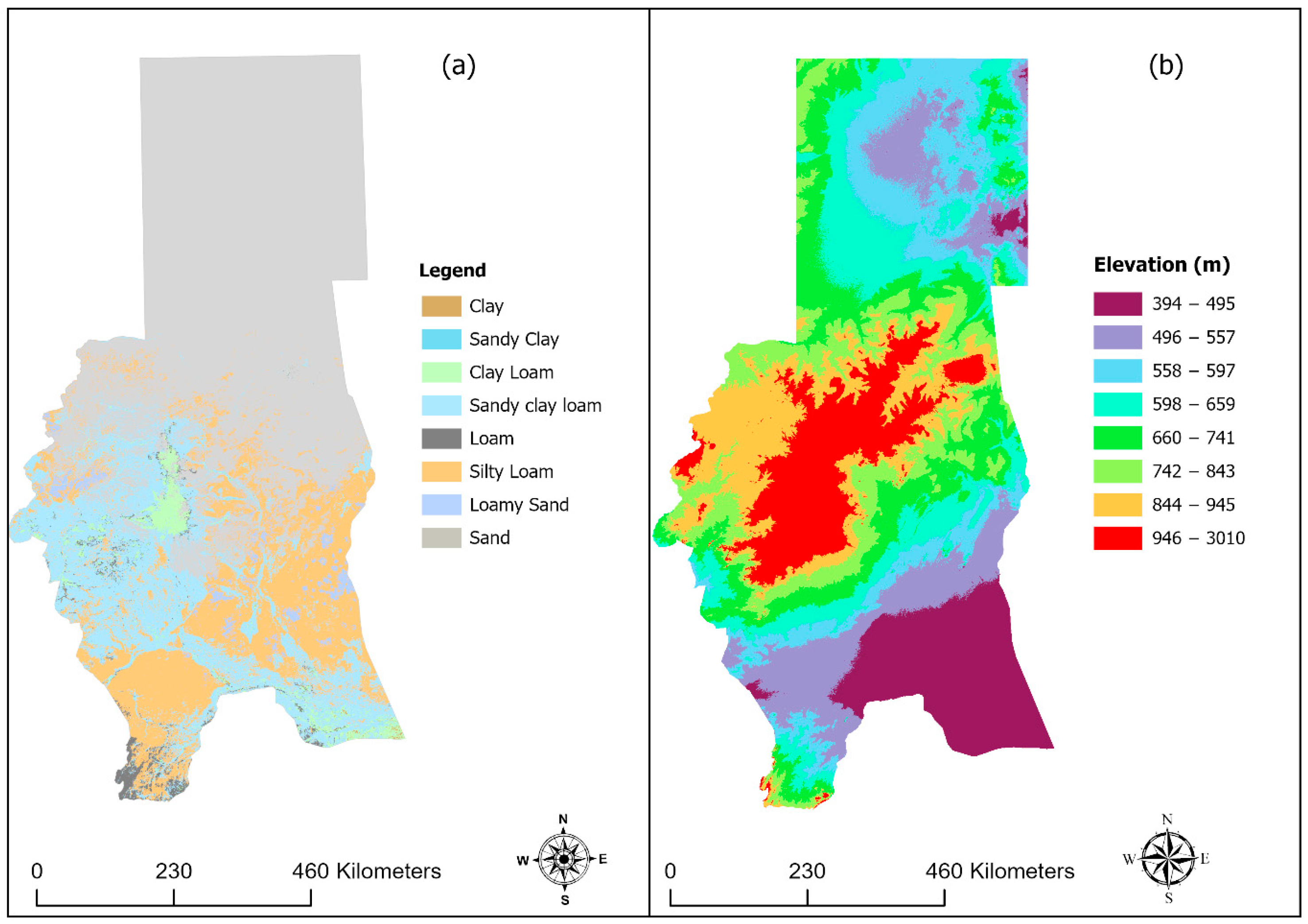

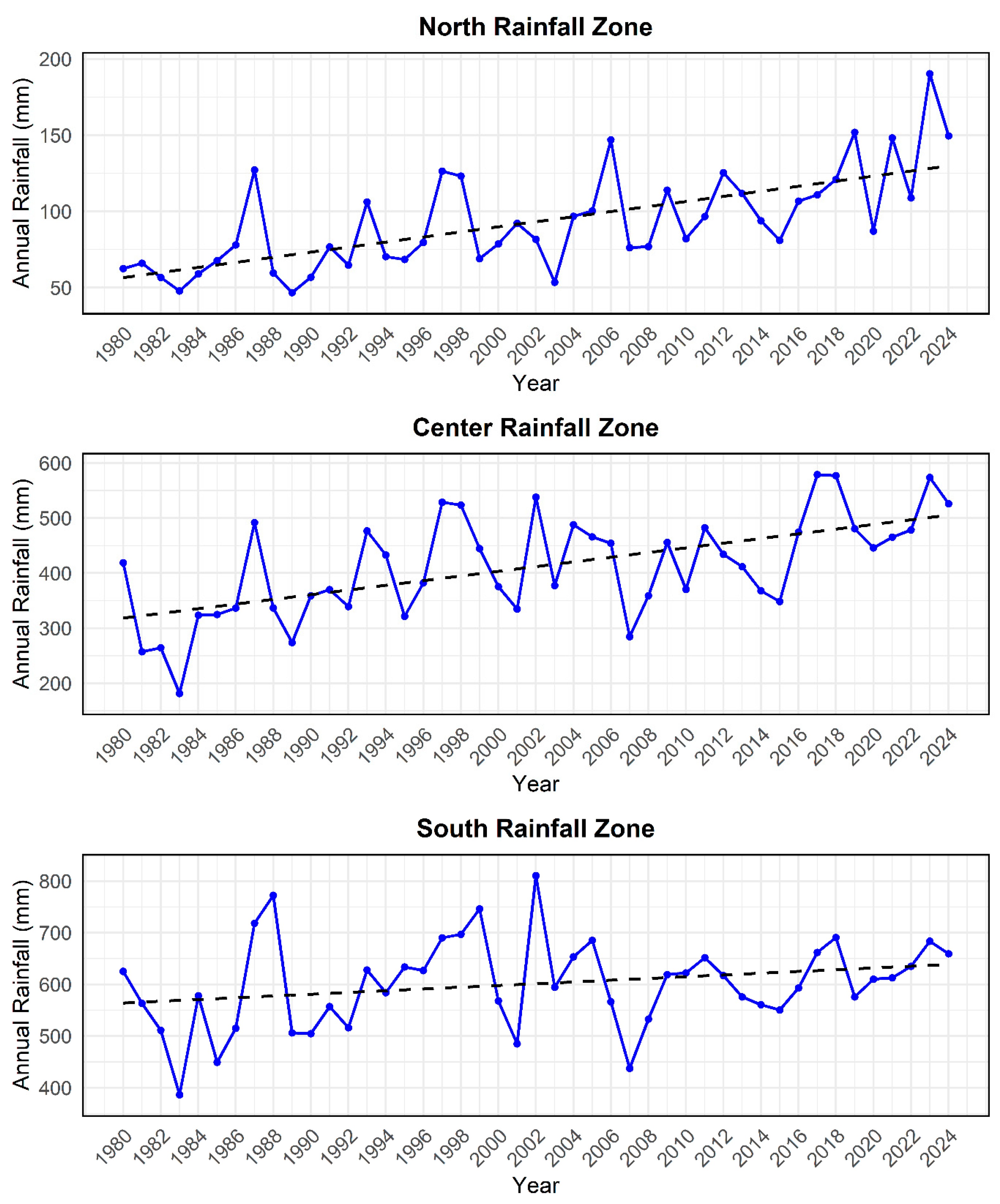

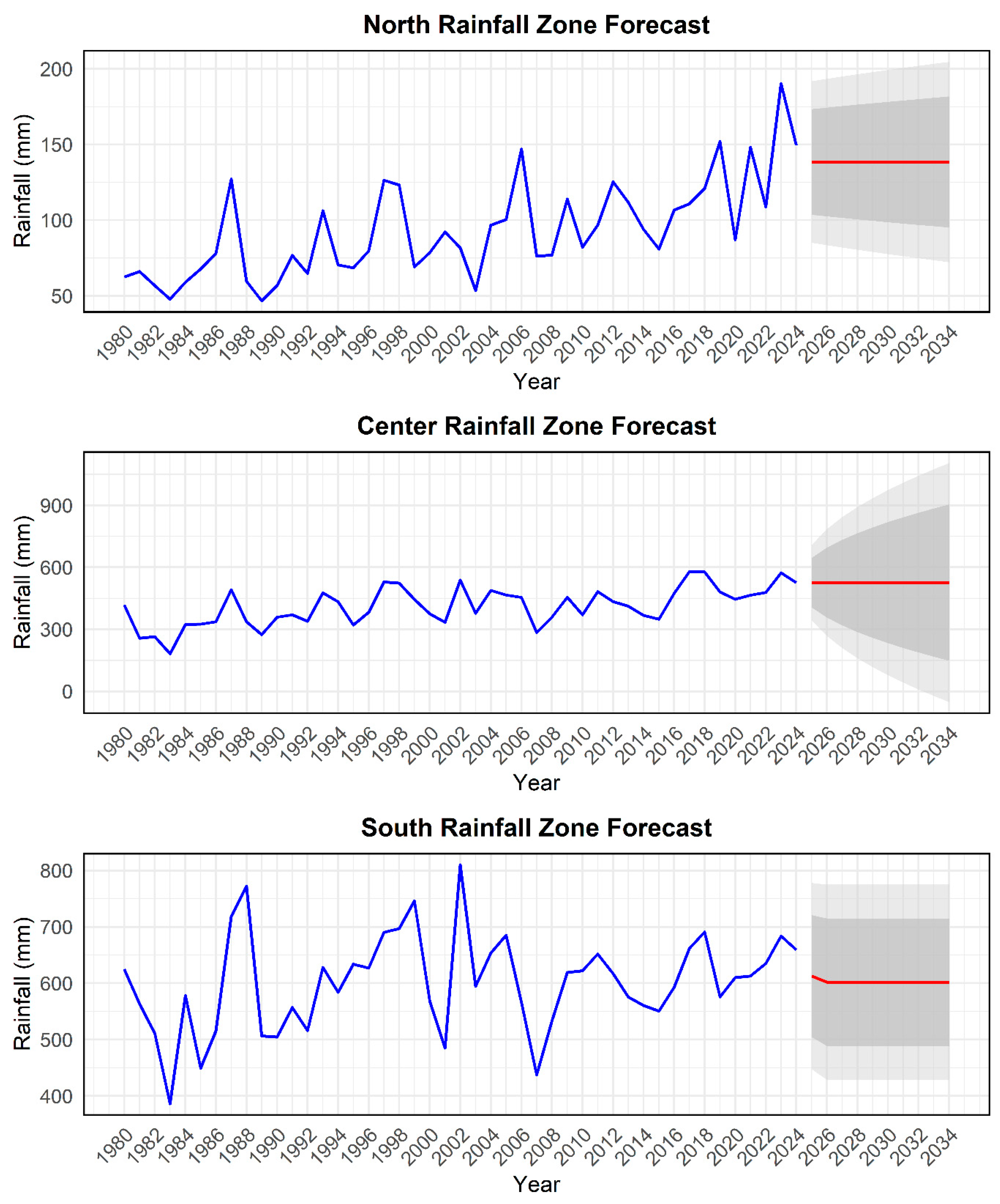
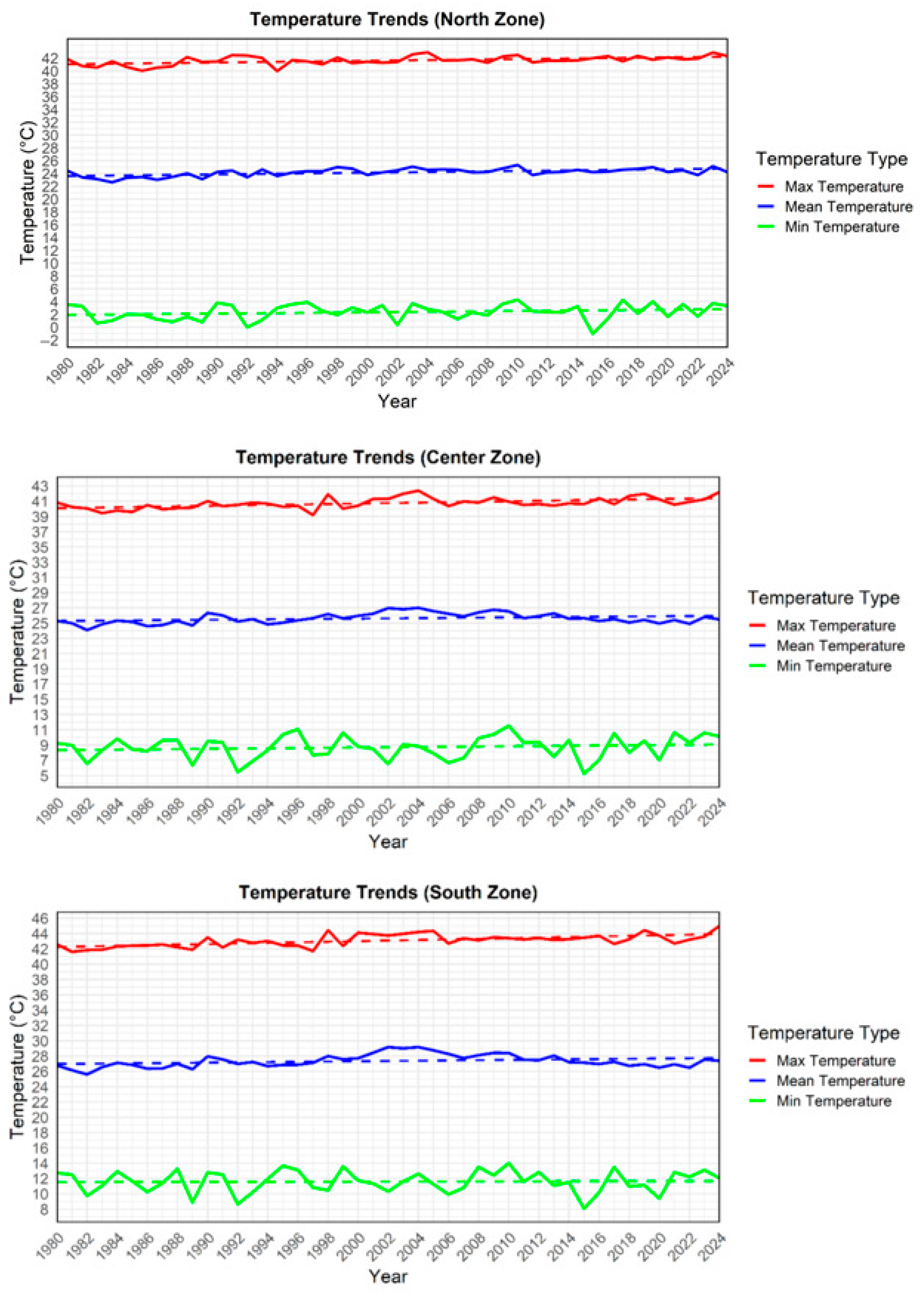
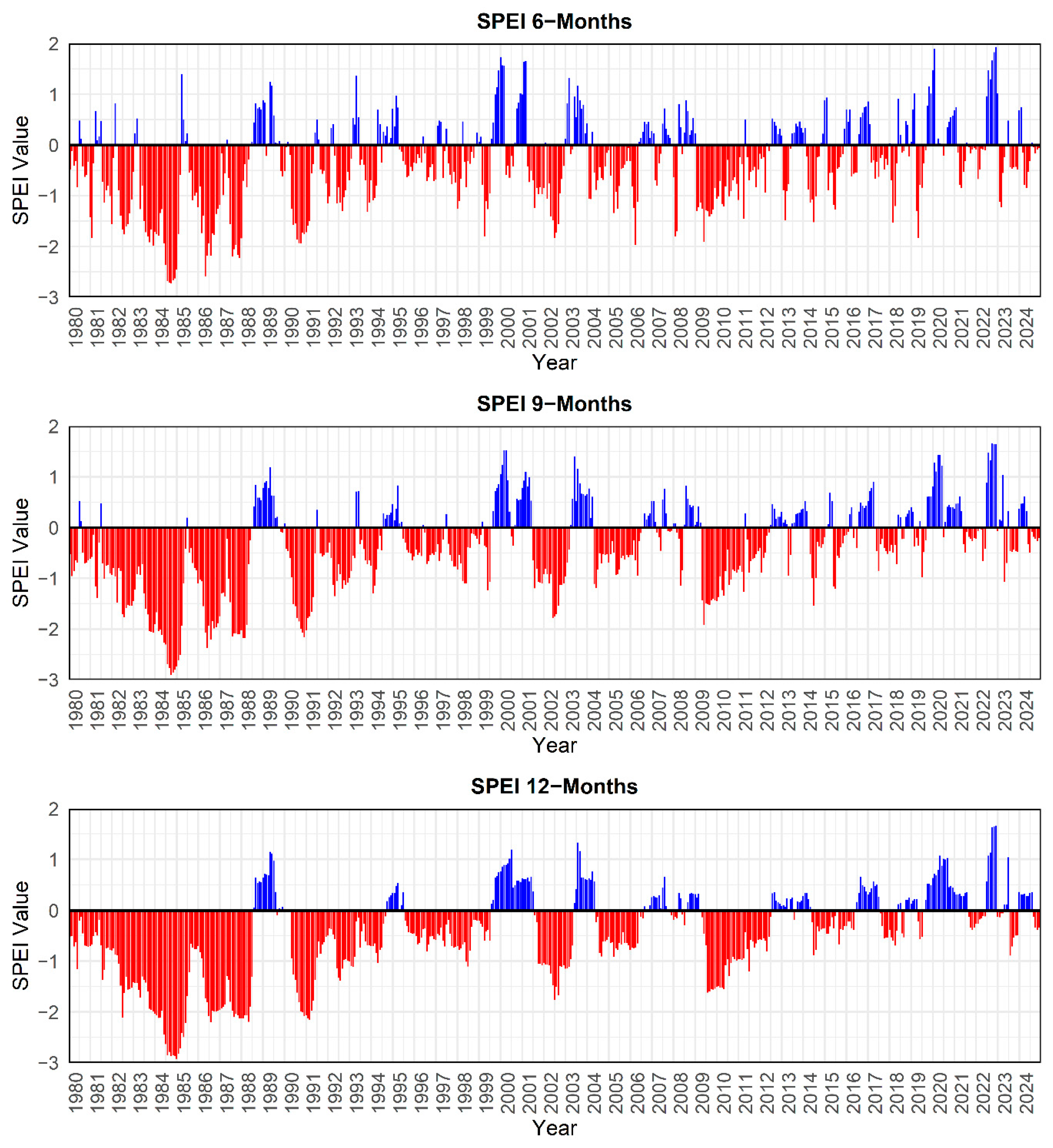
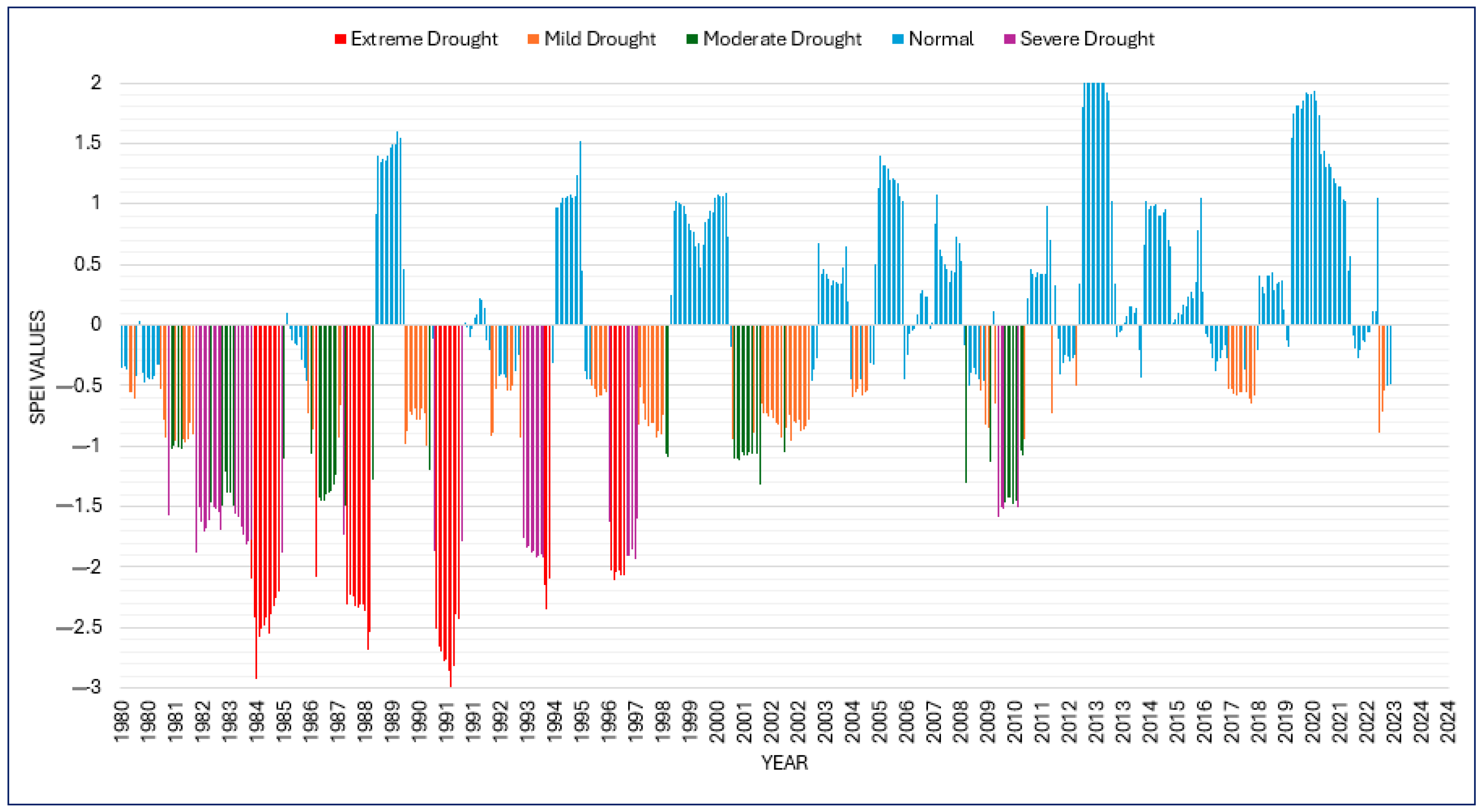


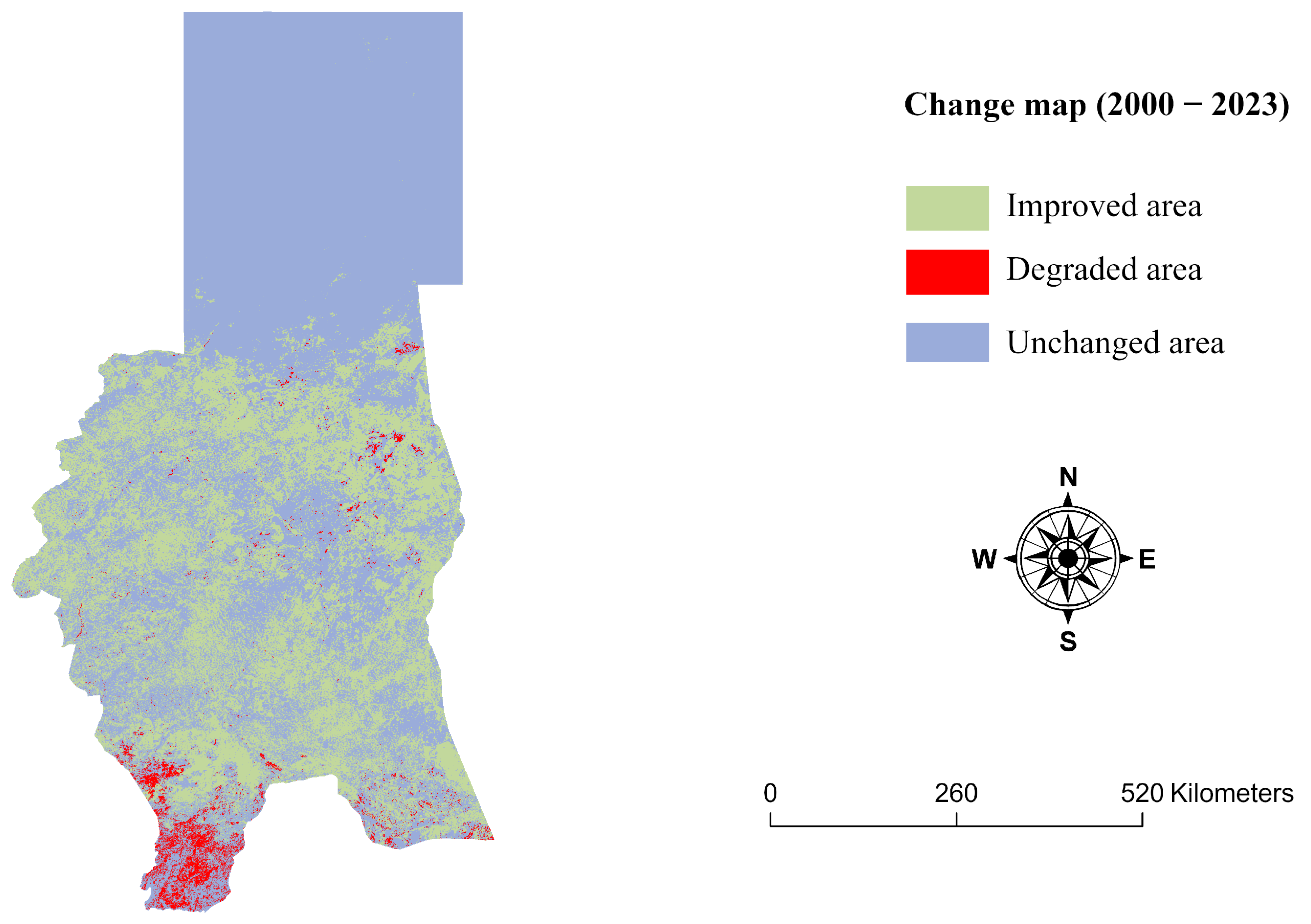
| Drought Category | Normal | Mild Drought | Moderate Drought | Severe Drought | Extreme Drought |
|---|---|---|---|---|---|
| SPEI Value | <−0.5 | −0.5 to −1.0 | −1.0 to −1.5 | −1.5 to −2.0 | >−2.0 |
| Class | No Vegetation | Low Vegetation | Moderate Vegetation | High Vegetation | Total | |
|---|---|---|---|---|---|---|
| 2000 | km2 | 262,131.31 | 147,671.25 | 95,478.63 | 26,023.06 | 531,304.25 |
| % | 49.34 | 27.79 | 17.97 | 4.90 | 100.00 | |
| 2005 | km2 | 259,526.13 | 136,294.38 | 113,795.13 | 21,688.63 | 531,304.25 |
| % | 48.85 | 25.65 | 21.42 | 4.08 | 100.00 | |
| 2010 | km2 | 255,493.88 | 145,958.00 | 102,094.00 | 27,758.38 | 531,304.25 |
| % | 48.09 | 27.47 | 19.22 | 5.22 | 100.00 | |
| 2015 | km2 | 261,514.63 | 150,476.06 | 99,293.50 | 20,020.06 | 531,304.25 |
| % | 49.22 | 28.32 | 18.69 | 3.77 | 100.00 | |
| 2020 | km2 | 233,420.94 | 150,028.25 | 105,196.13 | 42,658.94 | 531,304.25 |
| % | 43.93 | 28.24 | 19.80 | 8.03 | 100.00 | |
| 2023 | km2 | 205,242.44 | 132,593.88 | 133,160.88 | 60,307.06 | 531,304.25 |
| % | 38.63 | 24.96 | 25.06 | 11.35 | 100.00 |
Disclaimer/Publisher’s Note: The statements, opinions and data contained in all publications are solely those of the individual author(s) and contributor(s) and not of MDPI and/or the editor(s). MDPI and/or the editor(s) disclaim responsibility for any injury to people or property resulting from any ideas, methods, instructions or products referred to in the content. |
© 2025 by the authors. Licensee MDPI, Basel, Switzerland. This article is an open access article distributed under the terms and conditions of the Creative Commons Attribution (CC BY) license (https://creativecommons.org/licenses/by/4.0/).
Share and Cite
Ahmed, A.; Rotich, B.; Czimber, K. Climate Change as a Double-Edged Sword: Exploring the Potential of Environmental Recovery to Foster Stability in Darfur, Sudan. Climate 2025, 13, 63. https://doi.org/10.3390/cli13030063
Ahmed A, Rotich B, Czimber K. Climate Change as a Double-Edged Sword: Exploring the Potential of Environmental Recovery to Foster Stability in Darfur, Sudan. Climate. 2025; 13(3):63. https://doi.org/10.3390/cli13030063
Chicago/Turabian StyleAhmed, Abdalrahman, Brian Rotich, and Kornel Czimber. 2025. "Climate Change as a Double-Edged Sword: Exploring the Potential of Environmental Recovery to Foster Stability in Darfur, Sudan" Climate 13, no. 3: 63. https://doi.org/10.3390/cli13030063
APA StyleAhmed, A., Rotich, B., & Czimber, K. (2025). Climate Change as a Double-Edged Sword: Exploring the Potential of Environmental Recovery to Foster Stability in Darfur, Sudan. Climate, 13(3), 63. https://doi.org/10.3390/cli13030063






